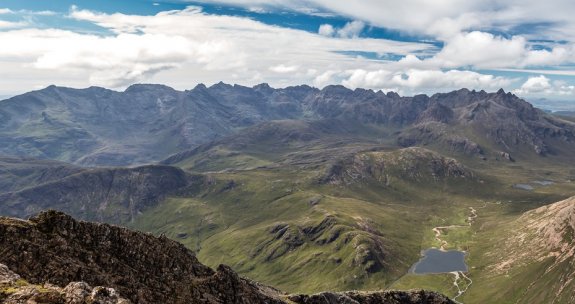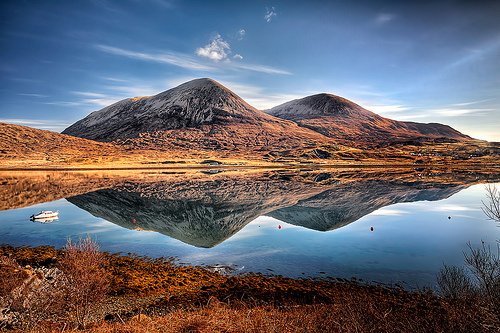The Isle of Skye lies close to the
northwest coast of the Scottish Highlands and it Scotland’s largest tourist
destination after Edinburgh. Rightfully so, as it contains what are thought to
be the only true mountains in Britain – the dramatic Cuillin and Red Hills. The
Cuillin, also known as the Black Cuillin, is a rugged ridge of peaks that are
the remains of a volcano. The Red Hills are the adjacent landforms to the Black
Cuillin, having a very different mineralogy and much gentler slopes than their
Cuillin neighbours. These mountains have been a mecca
for experienced climbers, scramblers and even hillwalkers for over 150 years. They
offer breathtaking views of the ancient volcanoes that once erupted on Skye and
also a range of satisfying ascents. Rising straight from the sea with little
vegetation, these mountains first appear precipitous, but if you get close
enough you see the enchanting scenery that the cloudy peaks offer. J. A Macculoch, a Scottish writer, put
this beauty into words on his first visit to the mountains: “Here and there a
black precipitous scour looms out of the hillside, but the hills themselves in
their white dresses are folded softly against the sky, and the snowy peaks of the
Cuillin shimmer away like some ethereal fantasy into the sapphire heaven. Were
it not for the shadows cast of the hills by their outstanding rocks and bluffs,
they might be fleecy clouds, forming and dispersing and reforming in dreamy
air.”
When compared to Skye, this mountain range seems relatively young, with
its formation beginning 50-70 million years ago. As North America began pulling
away from Europe, and the Atlantic Ocean began filling in, a chain of volcanoes
formed on the west of the Highlands, giving rise to the striking landscapes
seen on Skye. The Black Cuillin were formed first when lava erupted from
ancient volcanoes on Skye. This deposited basalt, a fine-textured volcanic rock
that cooled relatively fast. Another
plume of magma began rising to the surface,
Black Cuillin (left) with the Red Hills (right).
but moved too slowly to erupt from
the volcano and it began cooling slowly at great depths to form gabbro.
Through fissures in the crust, the basalt became injected with gabbro, a
coarse-grained relative of basalt. This formed the magnificent Cuillin mountain
range.
The rugged Black Cuillin mountain range.
At the same time, the magma plume had enough heat to melt the
surrounding country rock (composed of quartz, feldspars and micas) to form
granite. This red granite, its pigment coming from the feldspars, was uplifted
to form the gentle Red Hills that sit adjacent to the Cuillin.
All this solidified rock was subsequently covered under an extensive
lava field that covered most of Skye when it was volcanically active.
Weathering and erosion during the tertiary period removed vast proportions of
the lava field and uncovered
the subvolcanic intrusions that now make up the Cuillin and Red Hills. The
granites of the Red Hills have eroded uniformly, giving them their rounded
gentle slopes. The fine-grained basalt on the Black Cuillin have weathered much
quicker than the
 Post title...
Post title...



 Magazine Posts
Magazine Posts Table of Contents
Table of Contents